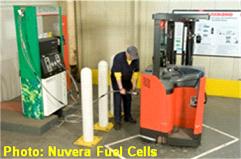Indoor Refueling of Hydrogen-Powered Industrial Trucks
Outdoor hydrogen fueling stations started to appear in select U.S. markets in the 1990s to provide fuel for fleets of hydrogen-powered cars and buses involved in demonstration projects. Fueling expanded indoors to support similar demonstration projects as large-scale warehouse operations replacing battery-powered industrial trucks with hydrogen-powered ones. By 2020, there were more than 50,000 hydrogen powered industrial trucks in operation in the United States.
Indoor fueling in a typical warehouse is safe because of the large air volume as compared to other indoor spaces (e.g., a residential garage); potential hydrogen leaks can disperse rapidly in a large volume resulting in a hydrogen concentration below hazardous levels.
Hydrogen can be as safe as, or safer than other means of energy storage used in industrial trucks.
- Propane-powered industrial trucks generally must be refueled outdoors, and the burning of propane in combustion engines can create CO an NOx emissions which are exhausted into the indoor operation space.
- Lead-acid batteries present space, handling, and ventilation challenges and can require extended recharging time.
Best practices for setting up an indoor refueling station for hydrogen-powered industrial trucks can be found in fire codes referenced by the jurisdiction.
Addition information can be found in the following webpages:
References
NFPA 52: Vehicular Natural Gas Fuel Systems Code
NFPA 55: Compressed Gases and Cryogenic Fluids Code
UL 2267: Standard for Fuel Cell Power Systems for Installation in Industrial Electric Trucks
OSHA 1910.103: Hydrogen


